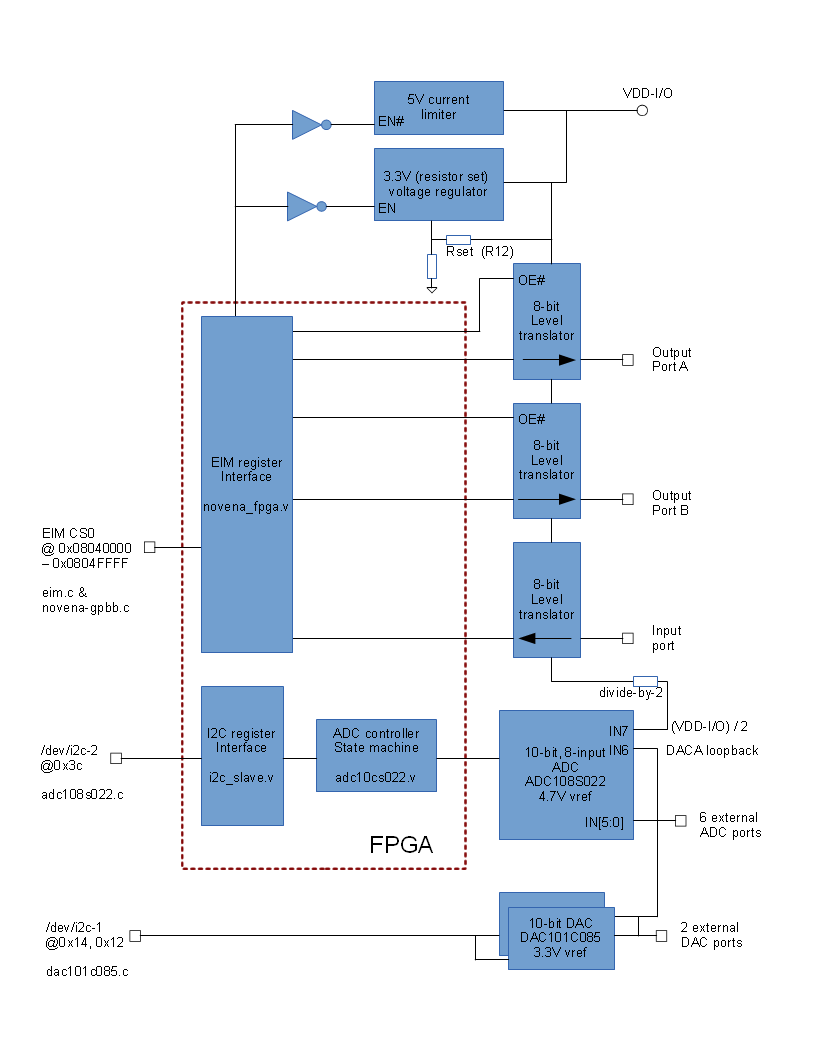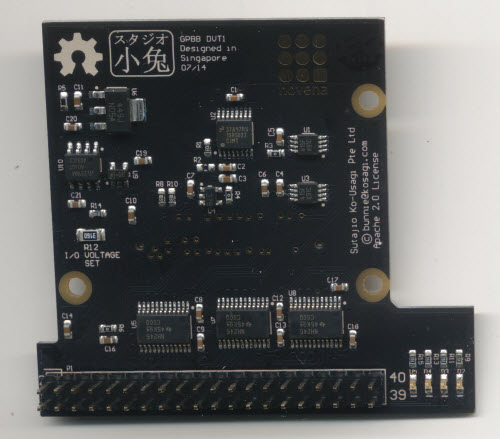Difference between revisions of "GPBB User Guide"
(→Command-line Firmware Example) |
(→Command-line Firmware Example) |
||
| Line 74: | Line 74: | ||
https://github.com/bunnie/novena-gpbb-example | https://github.com/bunnie/novena-gpbb-example | ||
| − | + | Before running the example program, you must configure the FPGA. You can do so using the shell script included in the above git repo as follows: | |
| + | |||
| + | sudo ./configure.sh novena_fpga.bit | ||
| + | |||
| + | The shell script basically configures the FPGA configuration reset pin, flips it (so the FPGA is erased), and then dd's the bitfile to /dev/spidev2.0. | ||
| + | |||
| + | The example program must be run as sudo, as it uses the /dev/mem interface to access the memory-mapped EIM CS0 and CS1 regions. | ||
The built-in help describes the usage of the program: | The built-in help describes the usage of the program: | ||
| Line 104: | Line 110: | ||
Burst-mode EIM access is provided for applications that require a high bus utilization. The i.MX6 takes about 32 cycles to turn the bus around between burst memory operations to the region. Thus, the CS0 interface, which transfers only one 16-bit word at a time, can achieve only about 3% utilization of the bus. Burst mode will perform a 64-bit access (4 words in an access) trivially, and can extend to much longer bursts with properly coded FPGA hardware. Even using the 64-bit accesses triples utilization to 10%. The example implemented in this codebase just does a loopback write/read of the CS1 space. | Burst-mode EIM access is provided for applications that require a high bus utilization. The i.MX6 takes about 32 cycles to turn the bus around between burst memory operations to the region. Thus, the CS0 interface, which transfers only one 16-bit word at a time, can achieve only about 3% utilization of the bus. Burst mode will perform a 64-bit access (4 words in an access) trivially, and can extend to much longer bursts with properly coded FPGA hardware. Even using the 64-bit accesses triples utilization to 10%. The example implemented in this codebase just does a loopback write/read of the CS1 space. | ||
| + | |||
| + | =FPGA Details= | ||
| + | The FPGA implementation can be found at | ||
| + | |||
| + | https://github.com/bunnie/novena-gpbb-fpga | ||
| + | |||
| + | The design is targeted to a Xilinx Webpack ISE "PlanAhead" flow (downloadable for free (but not open source) to run on x86 machines), so the novena-gpbb.ppr file would be the project container. This code is tested against Webpack ISE version 14.5 and can achieve 100% timing closure. | ||
Revision as of 15:40, 2 November 2014
The GPBB is a good entry point for most hardware hacking applications on Novena. This document describes in some detail about the function and theory of operation behind the GPBB.
Contents
GPBB Features
- Digital I/O
- 16 digital outputs organized in two 8-bit banks (A and B)
- Each bank can be individually tri-stated
- 8 digital inputs organized in a single 8-bit bank
- Switchable I/O voltage
- I/O VDD software switchable between +5V and a lower voltage
- Lower voltage I/O VDD nominally set to 3.3V but adjustable changing out a single resistor
- I/O VDD current-limited to 500mA
- In 5V mode, overcurrent indicator available
- I/O VDD can be sampled by on-board ADC to verify operation
- LEDs
- Four green LEDs
- Connected to port B bits 0-3
- Analog Input
- 6x 10-bit analog inputs
- 0-4.7V full scale range
- AVDD set by local LDO to +/- 1.5% accuracy
- Up to 200 ksps conversion rate
- Upgradable to 12-bit accuracy by swapping out ADC chip
- DAC-to-ADC loopback and VDD/IO measurement paths available
- Analog output
- 2x 10-bit analog outputs
- 0-3.3V full scale range
- Output speed limited by I2C bus rate (100kHz I2C -> ~5kHz output rate)
- Upgradable to 12-bit accuracy by swapping out DAC chips
GPBB Host Interface Features
The host interface to the GPBB is implemented using the FPGA. It is configurable, and therefore, this feature list should not be considered etched in stone. There is a lot of flexibility on how to implement the host interface, and this particular configuration was chosen to maximize the pedagogical value of the GPBB reference design.
- EIM register interface
- Modular, scalable register interface
- FPGA version reporting
- Loopback testing
- Control of the digital input and output ports
- CPU-> FPGA I2C register interface
- Example of communicating with the FPGA via I2C
- Control and readout of the ADC
- FPGA version reporting
- Loopback testing
- CPU->DAC I2C interface
- Direct bus interface to I2C with expansion card components
- Example of using expansion port with no FPGA intervention
- 2x DAC chips connected to CPU I2C bus
Block Diagram

Hardware Photo

Note R12, the voltage set resistor, is in the mid-left of the board in this photo.
Setting the I/O Voltage
The low voltage setting for the I/O is defaulted to 3.3V.
You can change this by desoldering R12, the larger 1206 resistor, and replacing it with one of the following:
- 316 ohm for 3.3V (default)
- 215 ohm for 2.5V
- 124 ohm for 1.8V
If you don't want to desolder the 316 ohm resistor, you can:
- Parallel a 680 ohm resistor with the default 316 ohm resistor to get 215 ohms
- Parallel a 200 ohm resistor with the default 316 ohm resistor to get 122 ohms
The 1206 resistor is large enough so one can fairly easily parallel an axial resistor across the surface-mount device.
Command-line Firmware Example
A command-line example program of using the GPBB can be found on github at
https://github.com/bunnie/novena-gpbb-example
Before running the example program, you must configure the FPGA. You can do so using the shell script included in the above git repo as follows:
sudo ./configure.sh novena_fpga.bit
The shell script basically configures the FPGA configuration reset pin, flips it (so the FPGA is erased), and then dd's the bitfile to /dev/spidev2.0.
The example program must be run as sudo, as it uses the /dev/mem interface to access the memory-mapped EIM CS0 and CS1 regions.
The built-in help describes the usage of the program:
bunnie@bunnie-novena-laptop:~/code/novena-gpbb-example$ sudo ./novena-gpbb
Usage:
./novena-gpbb [-h]
-h This help message
-v Read out the version code of the FPGA
-da <value> set DAC A to value (0-1024 decimal)
-db <value> set DAC B to value (0-1024 decimal)
-a <chan> set and read channel <chan> from ADC
-hv set VDD-IO to high (5V) voltage
-lv set VDD-IO to low (nom 3.3V unless you trimmed it) voltage
* GPBB has two 8-bit output-only ports (A,B), and one 8-bit input port
-oea <value> drive I/O bank A (value = 1 means drive, 0 means tristate)
-oeb <value> drive I/O bank B (value = 1 means drive, 0 means tristate)
-p <port> return last written <port> value in hex, port is [a,b] (note these ports are output-only)
-p <port> <hex value> set <port> to <hex value>
-p_set <port> <bit> set <port> <bit>
-p_clr <port> <bit> clear <port> <bit>
-rp return the value of the 8-bit input port
* CS1 isn't useful in the design, but loopback code provided as a template
-testcs1 Check that burst-access area (CS1) works
The test program incorporates all three interfaces (EIM CS0, I2C-1, and I2C-2) to drive the various interfaces. It also has an EIM CS1 example to mirror the example of using the burst-mode CS1 interface.
Burst-mode EIM access is provided for applications that require a high bus utilization. The i.MX6 takes about 32 cycles to turn the bus around between burst memory operations to the region. Thus, the CS0 interface, which transfers only one 16-bit word at a time, can achieve only about 3% utilization of the bus. Burst mode will perform a 64-bit access (4 words in an access) trivially, and can extend to much longer bursts with properly coded FPGA hardware. Even using the 64-bit accesses triples utilization to 10%. The example implemented in this codebase just does a loopback write/read of the CS1 space.
FPGA Details
The FPGA implementation can be found at
https://github.com/bunnie/novena-gpbb-fpga
The design is targeted to a Xilinx Webpack ISE "PlanAhead" flow (downloadable for free (but not open source) to run on x86 machines), so the novena-gpbb.ppr file would be the project container. This code is tested against Webpack ISE version 14.5 and can achieve 100% timing closure.